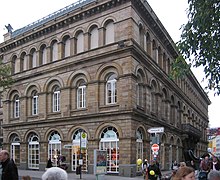Wall (Wuppertal)
The Wall is an inner-city shopping street in Wuppertal - Elberfeld . It begins at Neumarkt and leads south to the Wupper . This can be crossed there over the Icelander Bridge . From the end of 2012, the Wall will function temporarily as the central bus station in Wuppertal.
history
As the name of the street suggests, the course of the street follows the wall, the western city fortification of Elberfeld. This ran parallel to the street to the east and continued roughly in today's streets Grabenstrasse and Morianstrasse as well as along the Wupper. The city fortifications can probably be imagined as an earth wall with palisades. In the area of the “Wall” street, the Mirker Bach flowed towards the Wupper, which rises in the Uellendahl district . The central area of the city fortifications, in the area of the streets Turmhof and Burgstraße , was additionally reinforced militarily by Elberfeld Castle . It burned down in the 16th century, and residential buildings and the town hall were built in its place .
During the Thirty Years' War , Elberfeld was targeted several times. The fortifications proved too weak to offer protection to the population. Therefore, the facility was leveled and a road was built. This quickly developed into one of the most important streets in Elberfeld, which was documented by the location of the former town hall. In addition, the later so-called Isländer Bridge was the only permanent bridge over the Wupper for a long time.
When the enormous growth began, nothing changed in this central function, even if the bridge on Döppersberg , built in the 19th century, was the new focus of the city. Numerous elegant shops were opened in the classicist houses. Many of the buildings on the wall were destroyed in the air raids in World War II. The rebuilt houses did not succeed in replacing the atmosphere that had grown before the war.
Construction work on Döppersberg will begin at the end of 2012 . Work will begin on the B7 from the end of 2014 , so that the wall will have to serve as a temporary bus station for about three years until the new main station is completed.
architecture
The following architecturally interesting buildings should be emphasized:
- the old Elberfeld town hall , built in the classical Tuscan style , which served as the town hall until the opening of the Elberfeld town hall and now houses the Von der Heydt Museum .
- the former Fritzsche-Haus , a former textile department store built in 1901 with an elaborately designed staircase and an Art Nouveau facade that had been hidden behind aluminum panels for around 30 years since the 1970s
- At the corner of the Wall and Turmhof, the Michel department store , built in the Bauhaus style in the early 1930s by the architects Emil Fahrenkamp and Georg Schäfer , whose clear lines were also clad with the aluminum panels of a furniture store from the early 1970s to 1999
literature
- Klaus Peter Huttel: Wuppertalder Bilddokumente - A history book on the 19th century in pictures and text . Volume 1. Wuppertal 1985. ISBN 3-87093-007-1 . Pp. 52-63
Web links
- Architectural monument overview Wall in the Wuppertal monument list
Individual evidence
- ↑ Frequently asked questions about the Döppersberg renovation on wuppertal.de, accessed on August 26, 2012
Coordinates: 51 ° 15 '24.9 " N , 7 ° 8' 46.2" E



